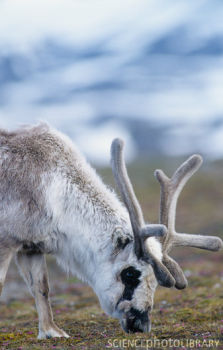由于披着蓬松的“毛皮大衣”到处乱跑,因此即便温度降至零下50摄氏度,驯鹿依然能够保持足够的体温,但是它们却往往在运动后无法让自己完全冷却下来。
为了搞清驯鹿到底是如何避免让身体过热的,研究人员挑选了9头他们所能找到的最温顺的驯鹿,并在它们头部的主要血管中植入了探测器,从而能够测量这些动物的血流情况和脑部温度。
随后,研究人员让这些驯鹿在一部特别设计的跑步机上奔跑。
研究人员发现,驯鹿首先会通过它们的鼻子呼吸,从而在将血液送至身体的其他部位之前,让北极地区的空气在鼻窦中冷却这些流体。
然而,一旦驯鹿开始急速地呼吸——达到每分钟260次,这些动物便会张开它们的嘴巴,像狗一样喘息,从而让空气流过它们的大舌头来冷却血液。
研究人员在12月出版的《实验生物学期刊》上报告说,当驯鹿的大脑温度达到临界极限39摄氏度时,它们便会打开鼻腔中的血流模式,从而使最冷的血液能够进入它们的头部并给大脑降温,这一策略与它们非常遥远的表亲——非洲羚羊——很类似。
驯鹿又名角鹿。是鹿科驯鹿属下的唯一一种动物。雌雄皆有角,角的分枝繁复是其外观上的重要特征。驯鹿主要分布于北半球的环北极地区,包括在欧亚大陆和北美洲北部及一些大型岛屿。(生物探索)
相关英文论文摘要:
Regulation of brain temperature in winter-acclimatized reindeer under heat stress
Reindeer (Rangifer tarandus) are protected against the Arctic winter cold by thick fur of prime insulating capacity and hence have few avenues of heat loss during work. We have investigated how these animals regulate brain temperature under heavy heat loads. Animals were instrumented for measurements of blood flow, tissue temperatures and respiratory frequency (f) under full anaesthesia, whereas measurements were also made in fully conscious animals while in a climatic chamber or running on a treadmill. At rest, brain temperature (Tbrain) rose from 38.5±0.1°C at 10°C to 39.5±0.2°C at 50°C, while f increased from ×7 to ×250 breaths min–1, with a change to open-mouth panting (OMP) at Tbrain 39.0±0.1°C, and carotid and sublingual arterial flows increased by 160% and 500%, respectively. OMP caused jugular venous and carotid arterial temperatures to drop, presumably owing to a much increased respiratory evaporative heat loss. Angular oculi vein (AOV) flow was negligible until Tbrain reached 38.9±0.1°C, but it increased to 0.81 ml min–1 kg–1 at Tbrain 39.2±0.2°C. Bilateral occlusion of both AOVs induced OMP and a rise in Tbrain and f at Tbrain >38.8°C. We propose that reindeer regulate body and, particularly, brain temperature under heavy heat loads by a combination of panting, at first through the nose, but later, when the heat load and the minute volume requirements increase due to exercise, primarily through the mouth and that they eventually resort to selective brain cooling.
英文论文链接:https://jeb.biologists.org/content/214/22/3850.abstract?sid=e995c74a-10de-46ed-b31f-6d84d1cb2fca








